The question, “How much does it cost to create an eScooter app” is attracting growing interest in the tech world. It's one of the most searched questions among mobility startups today.
The average development cost typically ranges from $20,000 to $250,000+, depending on features, platform, and complexity. A basic MVP will cost less, while a full-scale app like Lime or Bird will push toward the higher end.
In this blog, we’ll unpack everything that impacts the cost to create an eScooter app, from core features to tech stack, design, third-party integrations, and smart ways to optimize your budget.
Explore the full cost structure below.
What is an eScooter App?
An eScooter app is a mobile application that allows users to locate, unlock, ride, and pay for electric scooters on demand. These apps power shared mobility services by connecting users to nearby e-scooters through GPS tracking and real-time availability.
Users can view scooter locations, check battery levels, start rides via QR code scanning, and make digital payments all within the app. For operators, it offers fleet management, ride analytics, and maintenance tracking.
In essence, an eScooter app is the digital engine behind the growing micro-mobility movement in urban spaces. Let’s take a closer look at the market trends and future growth potential.
Market Overview of eScooter Apps
The shift toward greener urban transport is evident in eScooter app statistics, reflecting strong market performance and investor interest. These numbers highlight how eScooter apps are becoming key players in the future of urban transport.
Below are some key market overview-
-
- According to the Grand View Research, the global electric scooters market was valued at $37.07 billion in 2023 and is projected to reach $78.66 billion by 2030, growing at a CAGR of 9.9%.
- Shared Micromobolity Report shows that in the U.S., people took 133 million trips on shared micro mobility in 2023, a 16% increase from the previous year.
- Cities worldwide are integrating eScooters into smart mobility plans to reduce congestion and promote sustainability
- A report by Market.us, the global market for e-scooter rental apps is expected to grow from $2.37 billion in 2024 to $16.9 billion by 2034, with a compound annual growth rate (CAGR) of 21.70% over the forecast period from 2025 to 2034.
The future of urban mobility is clearly heading toward sustainability, and the latest trends of eScooter apps are playing a significant role in this transformation.
How Much Does it Cost to Develop an eScooter App?
If you’re wondering “how much does it cost to create an eScooter app”, the answer varies significantly based on app complexity, scalability, and development approach.
On average, the on-demand eScooter app development cost ranges from $20,000 to $250,000+.
A basic eScooter app development cost may start on the lower end, ideal for startups testing the market. In contrast, an advanced eScooter app development cost includes rich features like AI route optimization, IoT integration, advanced user analytics, and scalable backend systems pushing the budget much higher.
Here’s a detailed cost breakdown to give you better clarity:
|
App Type |
Estimated Development Cost |
Best Fit For |
|
Basic/ Essential eScooter App |
$20,000 – $60,000 |
Startups looking for MVPs with core features like user login, ride tracking, and payments. |
|
Standard eScooter App |
$60,000 – $140,000 |
Growing businesses need added features like real-time GPS, admin dashboards, and customer support. |
|
Advanced eScooter App |
$140,000 – $250,000+ |
Enterprises aiming for full-scale deployment with AI, IoT, multi-region support, and custom branding. |
Ultimately, the cost to create an app depends on your business goals, technology stack, and the features. Choosing the right development partner can make all the difference in optimizing both cost and value.
Factors Affecting the Overall Cost to Create an eScooter App
Are you trying to figure out the actual cost to create an eScooter app? Whether you're launching a basic MVP or the next best eScooter app in the market, it's important to understand which factors influence the final budget.
Below, we break down the key factors that contribute to the development cost of an eScooter app so that you can plan your investment smartly.
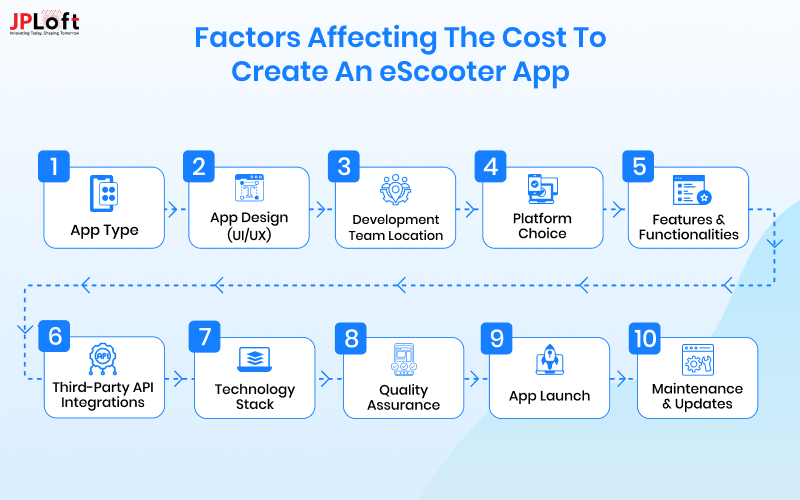
1. App Type
The first and most impactful factor on the cost to develop an eScooter app is the app’s type and complexity. You can build a simple user-side rental app or a full-fledged admin dashboard with live tracking, smart lock controls, and real-time analytics.
Naturally, the more features and integrations your app requires, the higher the electric scooter app creation cost will be.
Also, advanced features like AI route optimization or in-app diagnostics also raise your timeline and resources.
|
App Type |
Development Time |
Estimated Cost |
|
Basic |
3–5 months |
Low |
|
Moderate |
5–8 months |
Medium |
|
Complex |
8–12+ months |
High |
2. App Design (UI/UX)
Want to create an eScooter app design that looks sleek and feels smooth?
It can be a great idea, but keep in mind that design plays a big role in the eScooter app building cost. A basic, no-frills UI will be more budget-friendly.
However, if you’re going for custom animations, premium UX journeys, and branding-focused visuals, the price tag naturally climbs higher.
|
Design Type |
Description |
Estimated Cost |
|
Basic UI/UX |
Simple and clean design with standard components and minimal customization. |
Low |
|
Custom UI/UX |
Tailored designs that reflect brand identity with unique screens and flows. |
Medium |
|
Advanced Animations |
High-end visuals with custom graphics, transitions, and interactive animations. |
High |
3. Development Team Location
The region you choose to hire mobile app developers from can significantly impact the cost to build an eScooter app.
Developers in Asia or Eastern Europe may offer lower rates, but partnering with a US-based team ensures better alignment in communication, time zones, and quality standards.
It is one of the crucial factors for building a reliable, scalable, and compliant app for your users.
|
Location |
Average Hourly Rate |
Estimated Cost |
|
North America (USA/Canada) |
$100 – $180/hour |
High |
|
Western Europe (UK/Germany) |
$80 – $150/hour |
High |
|
Eastern Europe (Ukraine/Poland) |
$40 – $70/hour |
Medium |
|
Asia (India) |
$20 – $50/hour |
Low |
4. Platform Choice
One of the key decisions that impacts both cost and development time is choosing the right platform for your eScooter app. If you're building for a single platform either iOS or Android.
You can reduce initial expenses and time-to-market, making it ideal for MVPs or testing a specific user base. Cross-platform frameworks like Flutter or React Native allow you to develop for both platforms simultaneously.
It offers faster deployment and cost-efficiency, though sometimes with slight trade-offs in performance or native feel.
On the other hand, building native apps separately for both iOS and Android ensures the best performance, full access to device features, and a highly optimized user experience but it also demands a higher budget and longer development timeline.
|
Platform |
Description |
Estimated Cost |
Single Platform |
Faster delivery with limited reach |
Low |
Cross-Platform |
Balanced timeline for dual-platform support |
Medium |
Native for Both Platforms |
Longest time due to separate codebases |
High |
5. Features & Functionalities
The features of eScooter app you choose directly impact both user experience and the overall development cost. Basic features like ride history and payments are quicker to build.
On the other side, advanced functionalities such as geofencing, real-time tracking, or smart lock integration require more development time and testing, adding to the total cost.
The more complex the feature set, the higher the budget and timeline.
|
Feature Set |
Number of Features |
Estimated Cost |
|
Basic |
Limited |
Low |
|
Standard |
Medium |
Medium |
|
Advanced |
Extensive |
High |
6. Third-Party API Integrations
Need Google Maps, Stripe payments, or IoT integration for smart lock features?
All of these third-party services require licensing, backend work, and testing. This can increase the cost of making an eScooter app depending on the complexity and quantity of APIs integrated.
Choosing reliable APIs also ensures smoother performance, better user experience, and long-term scalability.
|
APIs Integrated |
Description |
Estimated Cost |
|
1–3 APIs |
Basic integrations like maps or payment gateways with minimal setup. |
Low |
|
4–7 APIs |
Moderate complexity with additional features like geofencing, notifications, or analytics. |
Medium |
|
8+ APIs |
Advanced integrations requiring IoT systems, real-time data sync, and custom logic. |
High |
7. Technology Stack
The technology stack you select from frontend frameworks and backend databases to cloud infrastructure, greatly influences the overall electric scooter app creation cost.
Using standard tools and frameworks can help keep costs manageable, while choosing advanced technologies like AI for predictive maintenance or blockchain for secure transactions will significantly raise both the budget and development time.
Each component of the stack adds to the complexity, so aligning your tech choices with your app’s goals is essential for balancing performance and cost-efficiency.
|
Tech Component |
Description |
Estimated Cost |
|
Frontend (Single Platform) |
Fast for a single OS |
Low |
|
Frontend (Multi-Platform) |
Needs more effort for compatibility |
Medium |
|
Backend Development |
Involves server, databases, APIs |
Medium |
|
Cloud Storage |
For scalability and performance |
Medium |
|
Security Protocols |
For data protection & encryption |
Medium |
|
API Integrations |
For maps, payments, IoT |
Low/Medium |
|
AI Features |
Advanced analytics & automation |
High |
8. Testing & Quality Assurance
App testing is crucial to ensure that your eScooter app functions smoothly across all devices and platforms.
A well-structured QA process helps identify and resolve bugs, glitches, and reduce long-term electric scooter app development cost. By investing in strong quality assurance, you not only enhance the user experience but also avoid costly fixes and updates down the line.
However, comprehensive testing covering multiple devices, OS versions, security protocols, and user scenarios requires more time and resources.
|
Testing Type |
Testing Scope |
Estimated Cost |
|
Basic Testing |
Core functionality only |
Low |
|
Security & Compliance |
Data protection layers |
Medium |
|
Load & Performance |
Multi-device and real-time testing |
Medium |
|
Cross-Platform Testing |
Various OS and devices |
Medium/High |
9. App Launch
Launching your eScooter app involves more than just development, it requires a strategic plan that includes marketing, App Store Optimization (ASO), and reliable user support. Once you're ready, you can publish your app on the play store or submit your app on the app store to make it available to users.
This stage is crucial for your app’s success, but it does add to the total cost as it involves efforts for promotion, updates, and user support after launch.
|
Launch Activity |
Timeline |
Estimated Cost |
|
Store Listings |
1–2 weeks |
Low |
|
App Store Optimization (ASO) |
2–4 weeks |
Medium |
|
Marketing Campaigns |
1–2 months |
Medium/High |
|
Post-Launch Bug Fixes |
1–3 months |
Medium |
10. Maintenance & Updates
This includes fixing any bugs, enhancing features, and improving overall performance based on user feedback.
Regular updates are important not only to keep the app running smoothly but also to engage users and encourage long-term retention.
This ongoing process of updates and improvements falls under app maintenance service, which should be factored into the total development cost. Since it’s a recurring investment, including it in your overall budget ensures long-term stability and performance of your eScooter app.
|
Launch Activity |
Timeline |
Estimated Cost |
|
Store Listings |
1–2 weeks |
Low |
|
App Store Optimization (ASO) |
2–4 weeks |
Medium |
|
Marketing Campaigns |
1–2 months |
Medium/High |
|
Post-Launch Bug Fixes |
1–3 months |
Medium |
Strategically prioritizing features and choosing the right tech stack can significantly reduce the cost to create an eScooter app without compromising on quality.
Hidden Cost of eScooter App Development
When asking how much does it cost to develop an eScooter app, most people focus only on the obvious expenses like coding, design, or feature implementation. It’s easy to overlook some critical hidden expenses.
These can significantly impact your overall eScooter mobile app development cost if not planned for in advance.
Here are the key hidden costs you should know:
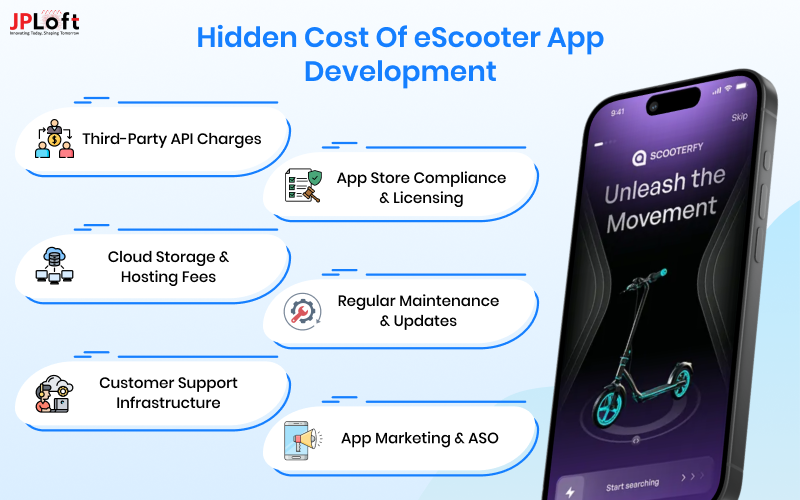
-
- Third-Party API Charges: To enable features like GPS navigation, digital payments, or scooter unlocking, you’ll likely need APIs such as Google Maps, Stripe, Razorpay, or IoT lock services. These APIs often charge on a per-transaction or monthly basis, which adds to your recurring costs. Choosing too many premium APIs without evaluating usage can inflate your overall development budget. It’s important to balance feature quality with long-term affordability during the planning stage.
- App Store Compliance & Licensing: When you create an eScooter app for multiple regions, local laws and mobility regulations may require special permits, licenses, or legal support, adding to the electric scooter app creation cost. This includes permits, insurance documentation, and app compliance to traffic and data privacy regulations. Sometimes you’ll need legal consultancy or licensing fees specific to each operating zone. Ignoring this aspect can lead to delays, fines, or app takedown notices, adding hidden costs to development.
- Cloud Storage & Hosting Fees: Features like GPS tracking, ride history, and payment data require reliable cloud solutions to store and process large volumes of data. Cloud providers such as AWS, Azure, or Google Cloud charge based on usage, storage, and bandwidth. These contribute significantly to the ongoing eScooter app development cost. Optimizing data storage and cloud usage can help reduce long-term infrastructure expenses.
- Regular Maintenance & Updates: Once you launch, you’ll need continuous support like bug fixes, OS compatibility updates, API upgrades, and new feature rollouts. Regular updates improve user experience and keep your app competitive. This often-overlooked area is a crucial part of mobile eScooter app development cost. Underestimating post-launch costs can lead to performance issues and loss of users.
- Customer Support Infrastructure: Smooth user experience relies on real-time help like live chat, support tickets, or AI-powered query handling. Setting up this system requires both technical integration and support staff. While it increases the eScooter app building cost over time, it’s essential for user trust. Investing in quality support improves retention and brand loyalty.
- App Marketing & ASO (App Store Optimization): To grow your user base, your app needs visibility through marketing and ASO strategies. This includes promotions, paid ads, influencer partnerships, and keyword optimization. Marketing tools and campaigns are often not included in the base making cost of eScooter app. Yet, without them, even the best apps struggle to gain traction.
So while estimating the eScooter app development cost, make sure you factor in these behind-the-scenes elements to avoid budget shocks and ensure smoother scalability.
Top eScooter App and How Much Does it Cost to Clone Them?
The eScooter clone app development cost varies widely depending on which brand you’re trying to replicate. Cloning a top app involves not just copying features but rebuilding backend systems, real-time tracking, and user logic from scratch.
Here’s a simple breakdown of top eScooter apps and the estimated cloning cost level:
|
eScooter App |
Short Description |
Cost to Clone (Estimate) |
Reason (Why Cost is High/Medium/Low) |
|
Bird |
A global eScooter platform known for smooth UX and powerful fleet control. |
$70,000 – $90,000 |
Complex GPS tracking, strong backend, and advanced user experience. |
|
Lime |
Offers eScooters, bikes, and public transport in one app. |
$75,000 – $95,000 |
Multi-vehicle system, IoT features, and real-time analytics. |
|
Spin |
Targets campuses and cities with a basic, clean system. |
$40,000 – $55,000 |
Fewer features and limited city-focused operations. |
|
VOI |
European app with stylish design and strong safety features. |
$45,000 – $60,000 |
Needs local law support, helmet checks, and safety education modules. |
|
Tier |
A German eScooter app known for eco-friendly rides and carbon-neutral operations. |
$70,000 – $85,000 |
Requires IoT, in-app sustainability tracking, and local compliance systems. |
When trying to match features of these apps, you may face the challenges of eScooter apps like real-time GPS syncing, fleet tracking, or scaling servers. Careful planning, skilled developers, and scalable backend architecture can match real-world expectations.
How to Reduce the Overall Cost to Develop an eScooter App?
Thinking about the cost to create an eScooter app and worried about the budget?
Then, here are some smart ways to cut down your eScooter app development cost without affecting quality or performance.
-
-
Start with an MVP (Minimum Viable Product): Build only the core features first—like user registration, GPS tracking, and ride booking. You can add advanced features later based on user feedback.
-
Use a Pre-Built eScooter App Template: Instead of developing everything from scratch, you can create an eScooter app using a clone or template. This saves time and development hours.
-
Choose Cross-Platform Development: Use frameworks like Flutter or React Native to build for Android and iOS together cutting down both time and cost.
-
Hire an Experienced App Development Company: The best mobile app development company can guide you through the right tech stack, avoid errors, and optimize backend architecture to lower long-term maintenance costs.
-
Outsource to Countries with Affordable Rates: Developers in regions like India or Eastern Europe often provide the same quality at a fraction of the price compared to the US or Western Europe.
-
By following these strategies, you can significantly lower the cost to develop an eScooter app while still building a reliable and scalable solution.
How to Make Money From an eScooter App?
If you're planning to build a profitable eScooter app, it’s essential to have a clear revenue strategy. A strong eScooter app business model helps you monetize efficiently while ensuring user satisfaction.
Here are the top ways to generate income:
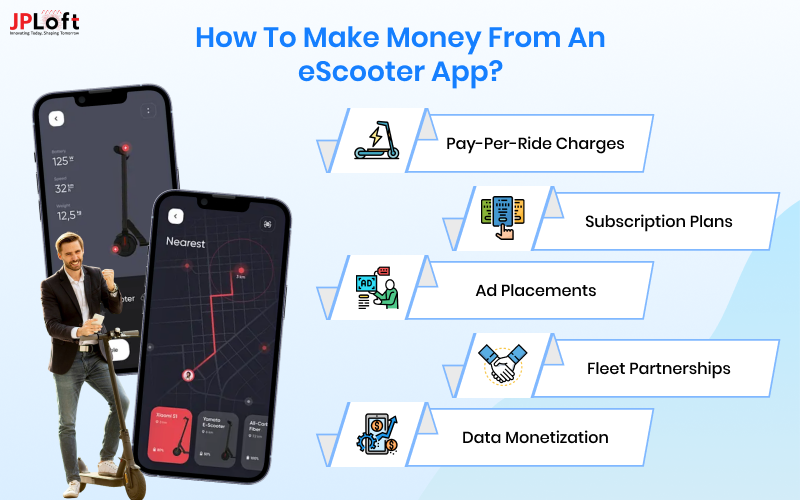
1. Pay-Per-Ride Charges
This is the most widely used model in the eScooter app business model. Users pay a fixed unlocking fee and then a per-minute riding fee. It’s simple, transparent, and ensures revenue with every ride.
You can also offer free unlocks as part of promotions or loyalty rewards.
2. Subscription Plans
Subscription plans provide users with daily, weekly, or monthly passes for unlimited rides. This model increases customer retention and predictable income flow. It appeals to regular commuters who prefer cost-effective options.
Offer tiered plans to suit different user needs and budgets.
3. Ad Placements
You can monetize your app through in-app banner ads or pop-ups. Also, can collaborate with local stores, cafes, or brands. Ads can be location-based, offering relevant promotions to users.
This creates a passive revenue stream without disrupting app usage.
4. Franchise or Fleet Partnerships
Allow third parties to operate your eScooter service under your brand. They manage local operations, while you earn through franchise fees. It’s a great way to scale without handling logistics in every region.
Provide them with tech, branding, and backend support in return.
5. Data Monetization
Your app can collect valuable, anonymized data from rider behavior. Urban planners and businesses can use this for traffic insights. You can sell this data or offer it as a premium analytics service.
Always ensure transparency and data privacy compliance.
By combining multiple income streams and aligning them with a smart monetization strategy, your eScooter app can grow sustainably while keeping users engaged.
Build a Powerful eScooter App with JPLoft Expertise
Looking for a reliable eScooter app development company to bring your idea to life?
JPLoft has years of experience building scalable, secure, and user-friendly eScooter apps tailored to modern mobility needs.
From GPS tracking and smart-lock integration to custom admin dashboards and payment systems, we handle it all.
Whether you're starting small or planning a city-wide fleet, our expert team ensures smooth development, faster time to market, and post-launch support.
With us, you don’t just build an app, you launch a business-ready solution built to perform in real-world scenarios.
Ready to build your eScooter app? Let JPLoft lead the way.
Final Wrap-Up
Building an eScooter app is not just a trend, it’s a smart investment in the future of urban transportation.
From understanding the hidden development costs to selecting the right monetization strategy and choosing the ideal tech partner, every step matters.
Whether you’re inspired by leading apps like Bird or Lime, or planning to start lean with a basic MVP, knowing the challenges can save you both time and budget.
As sustainability and smart mobility continue to shape modern cities, now is the perfect time to enter the market.
Let your app lead the way in smart and easy city travel.
FAQs
The average eScooter app development cost ranges from $20,000 to $250,000+, depending on features like GPS tracking, IoT integration, and backend complexity.
Key factors include app features (like GPS tracking, payments, fleet management), design complexity, backend infrastructure, platform choice, and whether you're building from scratch or using a clone.
Yes, by starting with an MVP, using cross-platform development, choosing pre-built templates, and outsourcing to experienced yet affordable developers, you can significantly reduce costs.
On average, it takes 3 to 6 months for a fully functional app, depending on the features and customization required.
Yes, using an eScooter clone app can lower costs and speed up development, but you may need to customize it to fit your brand and business goals.





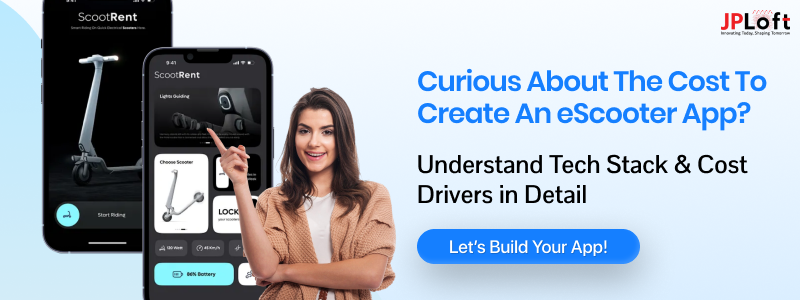
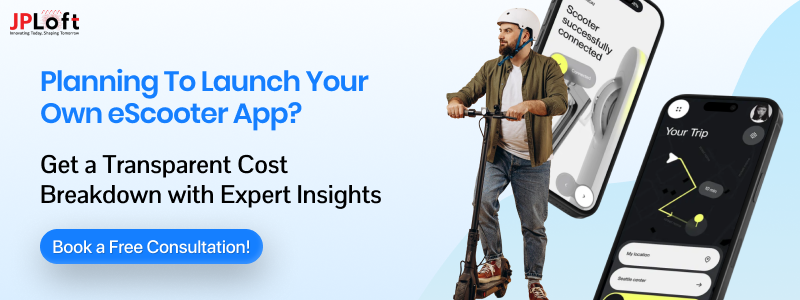

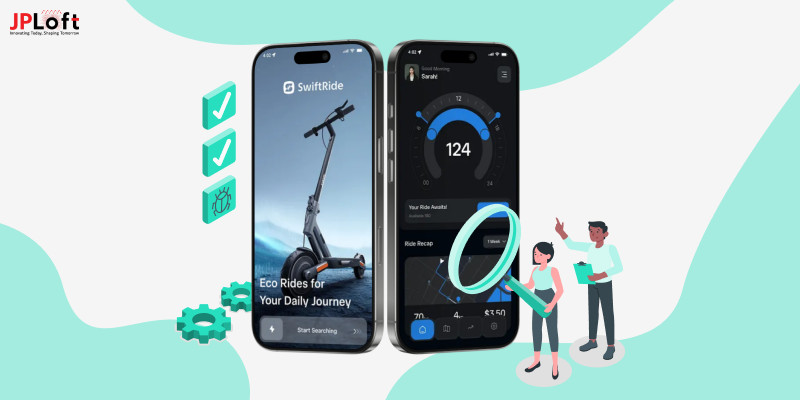
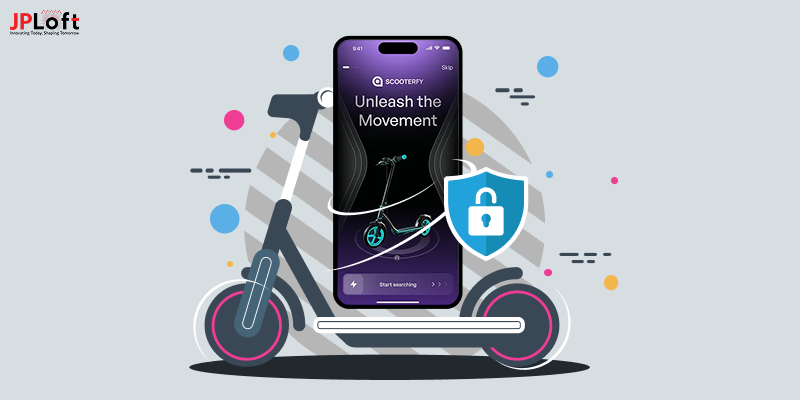
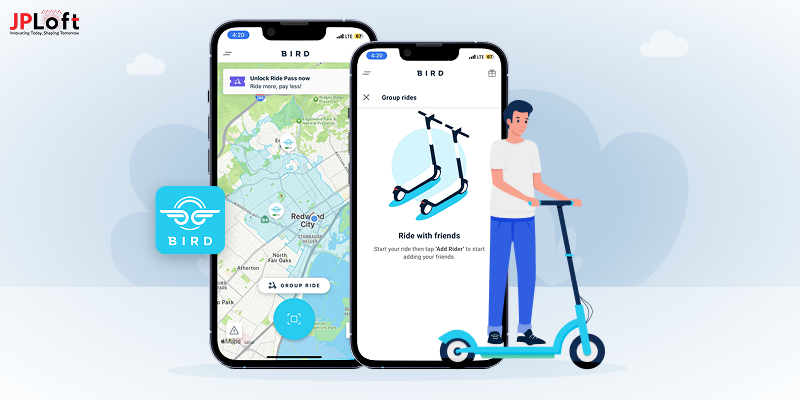


Share this blog